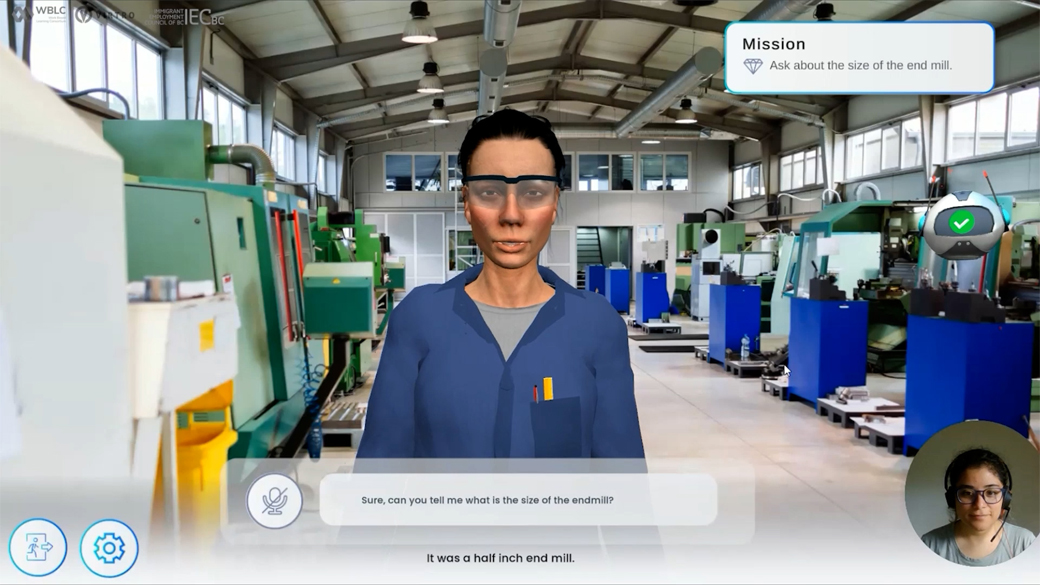In a world-first initiative, the Work Based Learning Consortium (WBLC) has partnered with artificial intelligence (AI) conversation company Virtro Technology to introduce an AI-powered simulation program. This program assists CNC machinists in learning technical language verbally and helps to prepare them for work on a busy manufacturing shop floor.
This program utilizes simulations that teach trainees how to use approximately 70 technical terms in contextual conversations with managers and co-workers. In these innovative simulations, AI virtual humans play the roles managers and co-workers, and the trainees learn how to have fluent conversations using these technical terms. The simulations build upon powerful elearning tools that are at the core of CNC Machinist training.
| “WBLC’s technical language simulations using artificial intelligence are changing the way that trainees learn in this sector.” |
“WBLC’s technical language simulations using artificial intelligence are changing the way that trainees learn in this sector,” says Rod Jones, Managing Director of WBLC. “Our partnership with Virtro has allowed us to create a program that is immersive and interactive, giving trainees an experiential learning experience.”
The introduction of this AI-powered simulation into WBLC’s elearning was funded by Future Skills Centre, a pan-Canadian initiative dedicated to helping Canadians gain the skills needed to thrive in a changing labour market.
How It Works
The Workplace Technical Language Simulations program is geared towards both new and immigrant CNC machinists and operators. The comprehensive program of simulations takes learners from high levels of support in initial conversations to workplace-ready conversations with managers and co-workers as they discuss work projects and solve job problems.
Each simulation was designed and developed with seasoned industry experts collaborating with the technical team to closely mirror real conversations that trainees will encounter as they start work.
| “People need to practice very specific work-related conversations, and this tool allows for that.” |
“People need to practice very specific work-related conversations, and this tool allows for that,” says Jordan Brighton, CEO of Virtro. “The AI-powered simulations offer a unique opportunity for trainees to interact with virtual humans and practice their conversations as many times as they need to become competent.”
Strong Participant Feedback
Participant feedback continues to be very positive with one trainee machinist stating, “I found the simulations to be incredibly useful in helping me improve my communication skills on the shop floor. The fact that I could practice as many times as I needed was invaluable, and the AI-powered virtual humans made the simulations feel very real.”
Another said, “I was impressed by the level of interactivity that the simulations offered. I was able to practice my conversations in a safe and controlled environment, which gave me the confidence I needed to use the technical language on the job.”
| “I was able to practice my conversations in a safe and controlled environment.” |
After one of the Workplace Technical Language Simulation Programs had been completed and 12 people had graduated, it was discovered that nine of the 12 graduates had continued to use the system and practice their conversational skills.
“I’ve been in education for close to 30 years and the typical reaction, after completing a course, is frequently ‘Whew, I got my certificate and I’m out of here’. That was not the case with this program. We saw for the next two weeks, people were going back in and practicing. That told me more than anything else, that we hit the nail on the head,” adds Brighton.
With a high success rate among graduates, the program has the potential to revolutionize the way CNC machinists learn technical language.
“We’re thrilled to have partnered with WBLC to develop a program that has the potential to significantly impact productivity and communication in the workplace,” says Brighton. “We believe that this program is just the beginning, and we’re excited to see how AI-powered simulations can continue to transform the way that people learn and practice new skills.”

